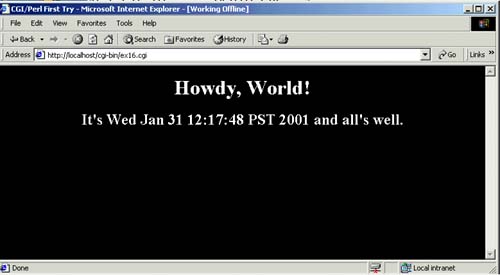C.4 How HTML and CGI Work Together
| As previously discussed, HTML is the markup language used to determine the way a Web page will be displayed. CGI is a protocol that allows the server to extend its functionality. A CGI program is executed on behalf of the server mainly to process forms such as a registration form or a shopping list. If you have purchased a book or CD from Amazon.com, you know what a form looks like. When a browser (client) makes a request of the server, the server examines the URL. If the server sees cgi-bin as a directory in the path , it will go to that directory, open a pipe, and execute the CGI program. The CGI program gets its input from the pipe and sends its standard output back though the pipe to the server. Standard error is sent to the server's error log . If the CGI program is to talk to the server, it must speak the Web language, since this is the language that is ultimately used by the browser to display a page. The CGI program then will format its data with HTML tags and send it back to the HTTP server. The server will then return this document to the browser where the HTML tags will be rendered and displayed to the user . Figure C.3. The client/server/CGI program relationship. C.4.1 A Simple CGI ScriptThe following Perl script consists of a series of print statements, most of which send HTML output back to STDOUT (piped to the server). This program is executed directly from the CGI directory, cgi-bin . Some servers require that CGI script names end in . cgi or .pl so that they can be recognized as CGI scripts. After creating the script, the execute permission for the file must be turned on. For UNIX systems, at the shell prompt type chmod 755 <scriptname> or chmod +x <scriptname> The URL entered in the browser Location window includes the protocol, the name of the host machine, the directory where the CGI scripts are stored, and the name of the CGI script. The URL will look like this: http:// servername /cgi-bin/perl_script.pl The HTTP HeadersThe first line of output for most CGI programs is an HTTP header that tells the browser what type of output the program is sending to it. Right after the header line, there must be a blank line and two newlines. The two most common types of headers, also called MIME types (which stands for multipurpose Internet extension), are "Content-type: text/html\n\n" and "Content-type: text/plain\n\n." Another type of header is called the Location header, which is used to redirect the browser to a different Web page. And finally, Cookie headers are used to set cookies for maintaining state; that is, keeping track of information that would normally be lost once the transaction between the server and browser is closed. Table C.5. HTTP headers.
Right after the header line, there must be a blank line. This is accomplished by ending the line with \n\n in Perl. Example C.61 #!/bin/perl 2 print "Content-type: text/html\n\n "; # The HTTP header 3 print "<HTML><HEAD><TITLE> CGI/Perl First Try</TITLE></HEAD>\n"; 4 print "<BODY BGCOLOR=Black TEXT=White>\n"; 5 print "<H1><CENTER> Howdy, World! </CENTER></H1>\n"; 6 print "<H2><CENTER> It's "; 7 print "<!--comments -->"; # This is how HTML comments are included 8 print `date`; # Execute the UNIX date command 9 print "and all's well.\n"; 10 print "</H2></BODY></HTML>\n"; EXPLANATION
Figure C.4. Output from the CGI program in Example C.6. |
EAN: 2147483647
Pages: 150

